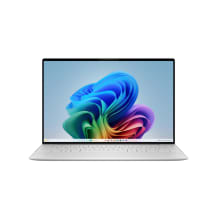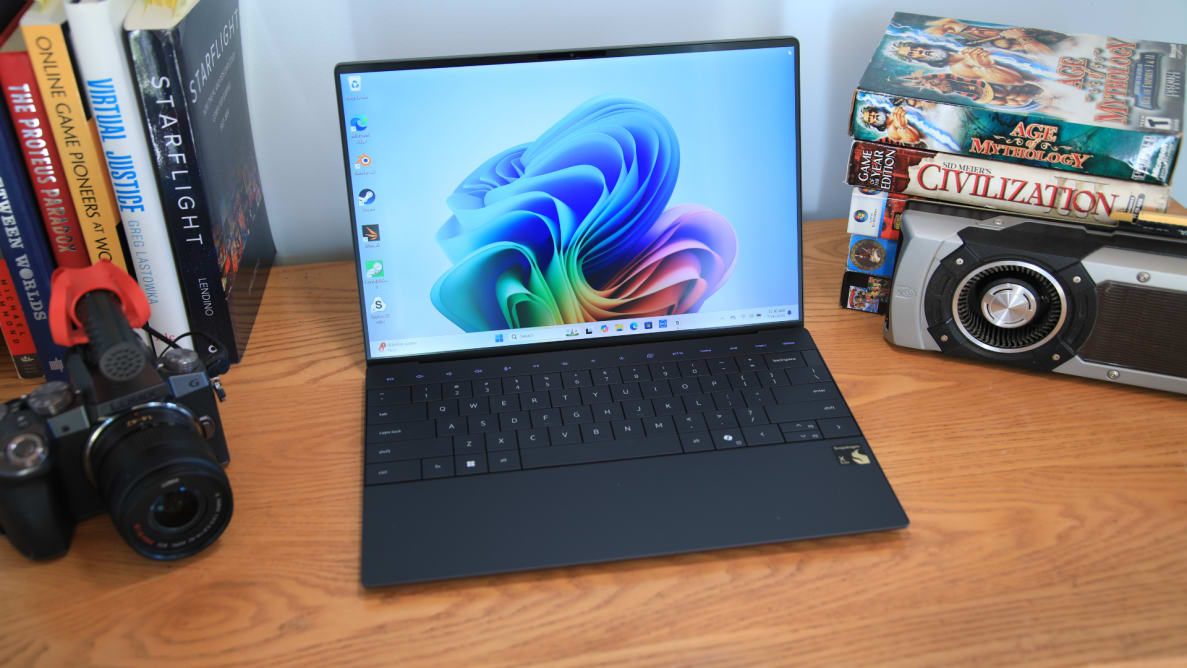Pros
-
Excellent processor performance
-
Great battery life
-
Attractive, slim design
Cons
-
Touch-sensitive function row is clunky
-
Limited port selection
-
IPS display fails to impress
About the Dell XPS 13 9345
The Dell XPS 13 9345’s most important specification is the processor. It uses the Qualcomm Snapdragon X Elite, a new Arm-based processor that looks to compete with Intel and AMD. It has 12 processor cores and Qualcomm Adreno integrated graphics.
Every Qualcomm-based Dell XPS 13 has this processor, so upgrades are limited to the RAM, storage, and display. The model we received was the base model with 16GB of RAM, 512GB of solid-state storage, and a 1,920 x 1,200 non-touch, anti-glare 120Hz display.
The options are significant, however: RAM goes up to 64GB, storage up to 2TB, and a 2,880 x 1,800, 60Hz tandem OLED touchscreen is available for an additional $500. Dell also offers a 2,560 x 1,600 IPS panel option for $300 more than the base model. A maximized XPS 13 will set you back $2,500, though we've seen the base model as low as $999 on sale.
Dell also offers an Intel-powered configuration officially known as the Dell XPS 13 9340. It’s similar to the Qualcomm model but has an Intel Core 7 155H processor and starts with only 8GB of RAM for $1,299. The Intel model is slightly more expensive in most configurations and costs about $2,600 with all the options ticked.
Dell XPS 13 9345 specs

The XPS 13 uses the same finish as the larger XPS 14 and 16.
- Price as configured: $1,300
- Processor: Qualcomm Snapdragon X Elite X1E-80-100 (12 cores up to 3.4 GHz)
- Graphics: Qualcomm Adreno integrated graphics
- Memory: 16GB LPDDR5 8,448MT/s
- Storage: 512GB PCIe 4.0 M.2 NVMe drive
- Display: 1,920 x 1,200 anti-glare, 120Hz IPS
- Ports: 2x USB-C with 40Gbps data, DisplayPort Alternate Mode, USB-C Power Delivery
- Connectivity: Wi-Fi 7E, Bluetooth 5.4
- Camera: 1080p webcam up to 30 frames per second, IR camera for Windows Hello facial recognition
- Battery: 54 watt-hours
- Weight: 2.62 pounds (1.19 kilograms)
- Dimensions: 11.62 x 7.84 x 0.60 inches
- Warranty: 1-year limited manufacturer warranty
- Special features: Touch-sensitive function row
What we like
Wow, it’s fast

The revamped XPS 13 uses the same lattice-free keyboard and touch row as the rest of the line.
Qualcomm’s Snapdragon X Elite processor is a new entry with 12 processor cores, all equally capable, at a clock speed up to 3.4 GHz (or 4GHz when just two cores are in use). The Snapdragon doesn’t use the x86 instruction set common to the Intel and AMD processors found in most prior Windows laptops. It instead uses the Arm instruction set relied on by Apple Silicon and Snapdragon chips for smartphones and a translation layer on top of that, which slightly hampers performance.
The Qualcomm chip is a brute and, better still, it’s slightly more powerful here in the Dell XPS 13 than in the similarly equipped Microsoft Surface Laptop 13.
Our Geekbench 6 results demonstrate this. The Dell XPS 13 achieved a single-core score of 2,799 and a multi-core score of 14,560; these are the fifth and second-best scores, respectively, that we’ve recorded from any productivity laptop to date. The [Microsoft Surface Laptop 13 was slower, scoring 2,276 and 13,086, respectively. The Lenovo Slim 7 with Intel Core Ultra 7 155H was slower in both tests with scores of 2,291 and 11,920. The Apple MacBook Air M3 13-inch produced a higher single-core score of 3,095, but a lower multi-core score of 12,089.
The Dell XPS 13 scored well in Blender, Excel, and browser-based benchmarks, too. Yet there is a catch: software must offer a native Windows on Arm version to deliver the best performance. Software developed only for x86 will run, but at reduced performance. Cinebench R23 brings the problem into focus. Here, the Dell XPS reached a multi-core score of 9,819. That’s not bad, but the Lenovo Slim 7 achieved 11,780 in the same test.
Qualcomm’s Adreno integrated graphics produced a competitive score of 24,116 in the 3DMark Night Raid benchmark, similar to laptops with Intel Arc graphics such as HP’s Envy x360 16. However, most games aren’t optimized for Qualcomm processors.
Steam, GOG, and the Epic Games Stores don’t currently support Windows on Arm and have no timeline for adding support. Even games for Xbox Game Pass usually don’t support Windows on Arm.
Until that changes, playing games on Qualcomm’s hardware is an uphill battle. Even when games work (and they often don’t), you’re likely to see results below what benchmark results would suggest.
Gaming aside, the Dell XPS 13’s performance is outstanding for a 13-inch laptop. It generally defeats the competition in multi-core tests, and sometimes does so by a sizable margin. That’s good news if you want a small, yet speedy, PC.
Battery life is solid
The Dell XPS 13 9345 ships with a 54-watt-hour battery. That’s not large for a laptop sold in 2024, but the processor’s efficiency makes up for it.
We recorded 18 hours and 38 minutes of battery life in our standard benchmark, which loops a series of web pages with the display at 200 nits of brightness to simulate web browsing. This is the fifth best result we’ve ever recorded from a productivity laptop, landing only behind the new Microsoft Surface Laptop 13, which also has a Qualcomm processor, and Apple MacBook laptops with Apple Silicon.
It’s an excellent result by any measure and it leaves many competitors with Intel and AMD processors in the dust. The Lenovo Slim 7 endured just seven hours and 37 minutes, while the LG Gram Pro achieved 14 hours and 3 minutes. The older Dell XPS 13 with an Intel Core i5-1230U delivered 16 hours and 13 hours of battery life, a result that was among the best of any Windows laptop we’d tested, but even it was a couple hours short of the new, Qualcomm-powered XPS 13.
The Dell XPS 13 charges over USB-C and only requires a 60-watt power adapter. While it ships with an adapter, its use of USB-C and low power requirement means travelers can easily swap to a modern multi-port USB-C charger to handle all their devices, simplifying the gear they must pack.
Dell’s design remains a leader
The Dell XPS line has a well-earned reputation as a leader in Windows laptop design that extends back a decade, and the latest XPS 13 lives up to expectations. Available in Graphite or Platinum, the XPS 13 strikes a sleek, professional profile. The laptop’s exterior has a subtle luster that glitters when the light strikes it right.
Opening the laptop reveals an interior that’s even more dramatic. Dell’s latest XPS 13, like the recent XPS 14 and XPS 16 laptops, has a borderless touchpad that blends into the palmrest. That might be annoying if the touchpad was small, but its usable surface is over five inches wide and three inches deep. I never “missed” the touchpad because the usable surface wasn’t visible. It also has a haptic feature that creates the sensation of a physical mouse button when you firmly tap the touchpad.
The keyboard, though the design’s weakest point, is acceptable. Key feel is fine with good key travel and some tactile feel, but it’s an obvious step behind leaders like the Apple MacBook Air M3 and Lenovo ThinkPad L13 Yoga. The layout is spacious and comfortable, a perk that shouldn’t be overlooked given the laptop’s small size.
What we don’t like
The connectivity is USB-C or bust

Invest in a USB-C dongle or dock to make the most of the XPS 13's two ports.
The Dell XPS 13’s wired connectivity is easy to describe. It has two USB-C ports and that’s it.
First, the good news: they’re excellent USB-C ports. Both support DisplayPort Alternate Mode, USB Power Delivery, and up to 40Gbps of data. That means if it’s USB-C, it should work with the Dell XPS 13, and any good gaming monitor these days will accept video-in over USB-C and charge your laptop at the same time.
A pair of USB-C ports isn’t much, and Dell also removed the 3.5mm audio jack. Most people who own the XPS 13 will need to buy a USB-C hub; that’s going to set you back an extra $50 to $250, depending on the type of USB-C hub you prefer and the ports you need. This also differs from some other Dell XPS laptops, like the XPS 14, which included a USB-C to USB-A and HDMI adapter.
The touch-sensitive function row isn’t great
The XPS 13’s keyboard is enjoyable but has a downside: The physical function key row is replaced by a row of backlit, touch-sensitive buttons. Because they’re not physical, it’s hard to know when your fingers touch them without looking, which becomes annoying when using shortcuts that rely on the function row (Control + Alt + Delete being the most famous example).
This begs the question: why change the function row? According to Dell’s past remarks, it lets the company’s engineers improve the laptop’s heat dissipation and optimize the design of the internal hardware. That claim is impossible to measure with precision, but it’s at least plausible. While the laptop’s exterior can get warm at full load, hitting up to 98.6 degrees Fahrenheit (37 degrees Celsius), that’s on par with many laptops including Apple’s MacBook Pro machines.
The basic 1080p display is good, but not great
Our Dell XPS 13 review unit shipped with the entry-level display, a 13.4-inch, 120Hz IPS screen with a resolution of 1,920 x 1,200 and an anti-glare finish. It’s good, but a step behind competitors with a similar price tag.
The anti-glare finish is the display’s best trait. It effectively reduces glare from overhead lights or nearby windows, which makes the screen easy to view in most situations. The laptop can still be hard to view outdoors on a bright summer, but not because of glare; rather, its maximum brightness of 504 nits isn’t high enough to compete with the sun. But many competitors are just as bright, or dimmer, or have a glossy display, so the XPS 13 fairs better in sunlight than most.
By most other metrics, however, the XPS 13 falls short. The XPS 13’s IPS display has a somewhat narrow color gamut of just 77 percent of DCI-P3. It produced a contrast ratio of 2,150:1, which is good for an IPS panel, but much lower than an OLED or Mini-LED display. Competitors like the Apple MacBook Pro 13 and Microsoft Surface 13 have displays with better color performance, and the Lenovo Yoga Slim 7X puts the XPS 13 to shame with a superb 2,944 x 1,840 OLED touchscreen that has an effectively infinite contrast ratio with perfect black levels (and it’s $100 less).
Dell offers its own optional OLED display, but it’s a steep $500 upgrade and paired with a RAM upgrade. It's the first tandem OLED display in a laptop and might offer an edge in performance over competing OLED displays, but we weren’t able to test this since Dell did not provide a model with the tandem OLED display.
What’s a Copilot Plus PC, anyway?
The new Dell XPS 13 is part of the Windows Copilot Plus PC line, which Microsoft announced in May of 2024. It was billed as a new category of AI-centric Windows laptop, but Microsoft botched the launch. It had to recall its most important new feature which, funnily enough, is called Microsoft Recall. It’s still not available and there’s still no release date.
Fortunately for Microsoft, Qualcomm saved the launch. Windows’ Copilot Plus PC features are mediocre, but all current Copilot Plus PCs use Qualcomm’s new processors and they’re excellent.
Should you buy the Dell XPS 13?
Yes, it is an excellent travel laptop

If you work remotely or need all-day battery life from your laptop, you won't be disappointed by the new XPS 13.
The Dell XPS 13 line has, in recent years, been challenged by the power consumption requirements of modern Intel processors, as we saw in the Dell XPS 13 9315. In response, Dell split the line into the more budget-conscious XPS 13, which had great battery life but mediocre performance, and the XPS 13 Plus, which delivered better (though still not excellent) performance with modest battery life. Shoppers had to choose.
Dell’s new XPS 13 with Qualcomm Snapdragon X Elite reunites the XPS 13 line-up. The XPS 13 Plus is gone, replaced with this new XPS 13 as the flagship model. Confusingly, Dell still offers an Intel-powered XPS but it’s a less appealing choice, not only because it offers a less attractive Intel Core Ultra processor, but also because the standard model has just 8GB of RAM.
The Qualcomm-powered XPS 13 is attractive compared to its rivals, though not without caveats. Alternatives with Intel processors, like the Lenovo Slim 7, can offer more RAM or storage at a similar price, but won’t last as long on battery. There’s also a selection of Qualcomm laptops from Microsoft, Lenovo, Acer, and Asus, among others. Most of these have a better standard display but most are also larger, so frequent fliers will prefer the svelte XPS 13.
Apple’s MacBook Air 13 M3 remains clearly ahead of the XPS 13 in most areas. It’s a tad thinner and lighter, has a better keyboard and touchpad, and offers a slightly better display, all with competitive performance and often comparable pricing.
But, of course, it’s a Mac. If you want or need MacOS, buy the Air—but if you don’t, the XPS 13 is a great Windows alternative.

The revised XPS 13 is thin, light, and offers excellent battery life.
Meet the tester
Matthew S. Smith is a veteran tech journalist and general-purpose PC hardware nerd. Formerly the Lead Editor of Reviews at Digital Trends, he has over a decade of experience covering PC hardware. Matt often flies the virtual skies in Microsoft Flight Simulator and is on a quest to grow the perfect heirloom tomato.
Checking our work.
Our team is here to help you buy the best stuff and love what you own. Our writers, editors, and experts obsess over the products we cover to make sure you're confident and satisfied. Have a different opinion about something we recommend? Email us and we'll compare notes.
Shoot us an email



